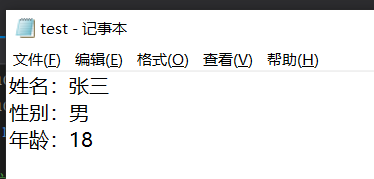1文件概述
1.1概念
程序运行时产生的数据都属于临时数据,程序一旦运行结束都会被释放,通过文件可以将数据持久化。
c++对文件操作需要包含头往文件<fstream>
1.2文件类型
- 文本文件:文件一文本的ASCII形式存储的计算机中
- 二进制文件:文件以文本的二进制形式存储在计算机中,用户一般不能直接读懂他们
1.3操作文件的三大类
- ofstream:写操作
- ifstream:读操作
- fstream:读写操作
2.文本文件
2.1写文件
写文件的步骤:
- 包含头文件:#include<fstream>
- 创建流对象:ofstream ofs
- 打开文件:ofs.open("文件路径",打开方式)
- 写数据:ofs<<"写入的数据";
- 关闭文件:ofs.close();
文件打开的方式:
| 打开方式 | 解释 |
| ios::in | 为读文件而打开文件 |
| ios::out | 为写文件而打开文件 |
| ios::ate | 初始位置:文件尾 |
| ios::app | 追加方式写文件 |
| ios::trunc | 如果文件存在先删除,在创建 |
| ios::binary | 二进制方式 |
注意:文件的打开方式可以配合使用,利用|操作符
写文件案例:
#include<iostream>
#include<fstream>
using namespace std;
//文本文件,写文件
void test01()
{
//创建流对象
ofstream ofs;
//指定打开的方式
ofs.open("test.txt", ios::out);
//写内容
ofs << "姓名:张三" << endl;
ofs << "性别:" << "男" << endl;
ofs << "年龄:" << "18" << endl;
//关闭文件
ofs.close();
}
void main()
{
test01();
}
在test.cpp的路径生成了一个test的文件,里面包含着:如下:

2.2 写文件
读文件与写文件步骤类似,但是读取方式相对于比较多
读文件步骤如下:
- 包含头文件:#include<fstream>
- 创建流对象:ifstream ifs
- 打开文件并判断文件是否打开成功:ifs.open("文件路径",打开方式)
- 读数据:四种方式读取
- 关闭文件:ifs.close();
读文件的案例:
#include<iostream>
#include<fstream>
#include<string>
using namespace std;
//文本文件,读文件
void test01()
{
//创建流对象
ifstream ifs;
//指定打开的方式,并判断是否打开成功
ifs.open("test.txt", ios::in);
if (!ifs.is_open()) {
cout << "文件打开失败" << endl;
return;//错了直接return掉就不会到下面读数据了
}
//读数据
//第一种方式读数据
//char buf[1024] = { 0 };//创建一个字符数组,把文件中的数据都放进字符数组中
//while (ifs>>buf)//一共有三行数据,利用一个循环读取
//{
// cout << buf << endl;
//}
//第二种方式读数据
//char buf[1024] = { 0 };//初始化字符数组
//while (ifs.getline(buf, sizeof(buf)))
//{
// cout << buf << endl;
//}
//第三种方式读数据
//string buf;
//while (getline(ifs,buf))
//{
// cout << buf << endl;
//}
// 第四种方式读数据(不推荐:因为他是一个一个字符读取的)
char c;
while ((c = ifs.get()) != EOF)//EOF=end of file就是指看有没有读到文件尾部
{
cout << c;
}
//关闭文件
ifs.close();
}
void main()
{
test01();
}
3.二进制文件
3.1概述
以二进制的方式对文件进行读写操作,打开方式要指定为ios::binary
3.2写文件
二进制方式写文件,主要利用流对象调用成员函数write
函数原型:ostream& write(const char * buffer, int len);
参数解释:字符指针buffer指向内存中一段存储空间,len是读写的字节数
#include<iostream>
#include<fstream>
#include<string>
using namespace std;
//二进制文件,写文件
class Person
{
public:
char m_Name[64];//姓名
int m_Age;//年龄
};
void test01()
{
//包含头文件
//创建流对象
ofstream ofs;
//打开文件
ofs.open("person.txt", ios::out | ios::binary);
//写文件
Person p = { "张三",18 };
ofs.write((const char *)&p,sizeof(Person));
}
void main()
{
test01();
}
 二进制文件,发现有些乱码,二进制文件打开就是容易乱码,只要我们可以读出来即可。
二进制文件,发现有些乱码,二进制文件打开就是容易乱码,只要我们可以读出来即可。
3.3二进制读文件
#include<iostream>
#include<fstream>
#include<string>
using namespace std;
//二进制文件,读文件
class Person
{
public:
char m_Name[64];//姓名
int m_Age;//年龄
};
void test01()
{
//包含头文件
//创建流对象
ifstream ifs;
//打开文件
ifs.open("person.txt", ios::in | ios::binary);
if (!ifs.is_open()) {
cout << "文件打开失败" << endl;
return;
}
//读文件
Person p;
ifs.read((char*)&p, sizeof(Person));
cout << "姓名:" << p.m_Name << "年龄" << p.m_Age << endl;
//关闭文件
ifs.close();
}
void main()
{
test01();
}






 本文介绍了C++中文件操作的基本概念,包括文件类型的区分、文本文件和二进制文件的读写方法。通过示例展示了如何使用ofstream、ifstream及fstream进行文件的打开、读取和写入操作。
本文介绍了C++中文件操作的基本概念,包括文件类型的区分、文本文件和二进制文件的读写方法。通过示例展示了如何使用ofstream、ifstream及fstream进行文件的打开、读取和写入操作。

















 424
424

 被折叠的 条评论
为什么被折叠?
被折叠的 条评论
为什么被折叠?










